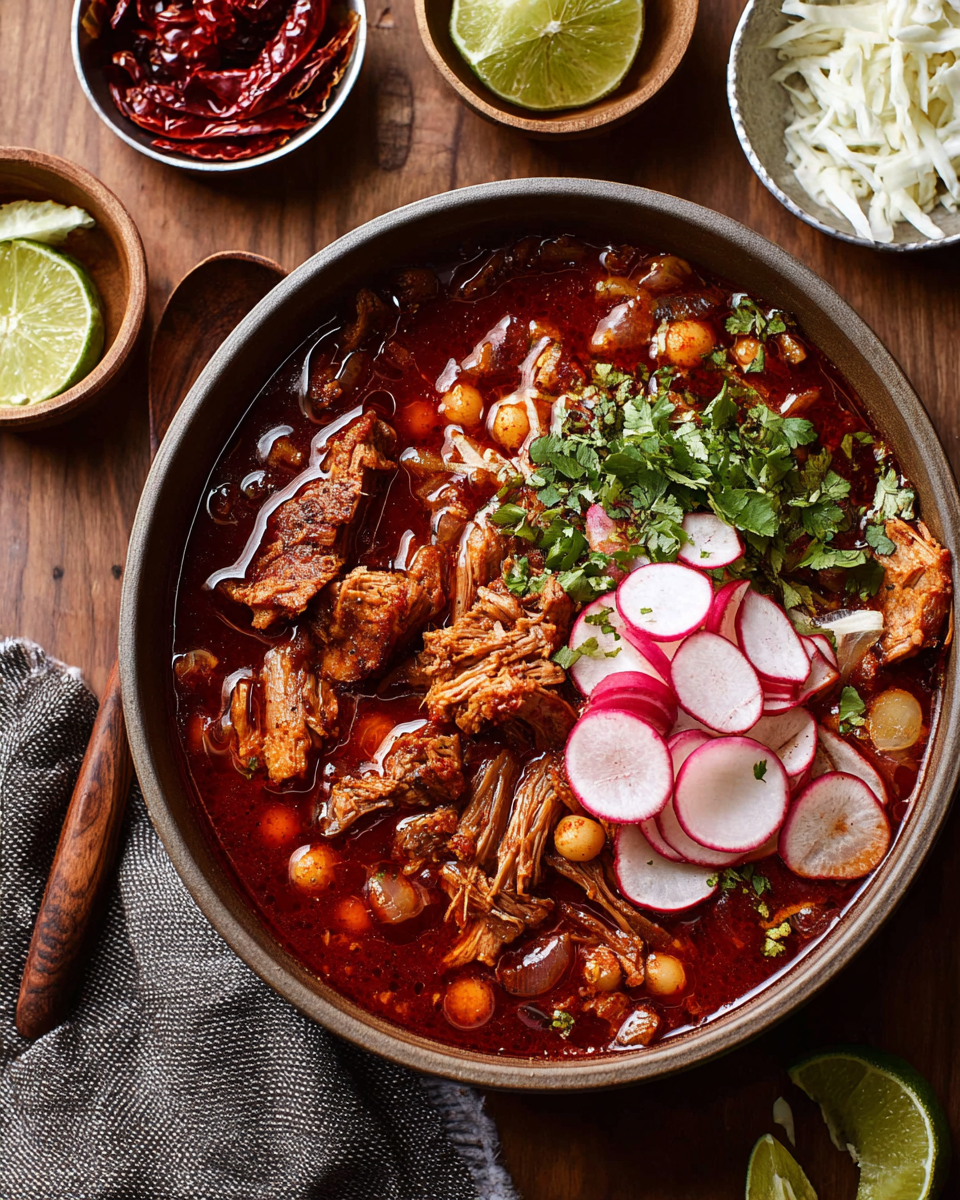Red Posole is a traditional Mexican dish that’s hearty, spicy, and packed with comforting flavors. The tender pork and hominy are bathed in a rich, smoky broth made from dried guajillo and ancho chiles, offering a depth of flavor that’s perfect for a cozy meal on a cold day. Topped with crunchy tortilla chips, fresh cabbage, tangy lime, and crisp radishes, this dish is a symphony of textures and tastes.
With its vibrant red color and rich broth, Red Posole not only warms you from the inside out but also brings the essence of Mexican comfort food to your table. Whether you’re enjoying it with loved ones or making it for a solo treat, this dish is a reminder of the hearty, soulful flavors of Mexican cuisine. It’s easy to make and can be adjusted to your preferred level of spice, making it a go-to recipe for any occasion.
Full recipe:
Ingredients:
-
2 pounds pork shoulder, cut into chunks
-
8 cups water
-
1 onion, quartered
-
5 cloves garlic, peeled
-
1 bay leaf
-
2 teaspoons salt, divided
-
1 (15-ounce) can hominy, drained and rinsed
-
3 dried guajillo chiles, seeds removed
-
2 dried ancho chiles, seeds removed
-
1 tablespoon olive oil
-
1/2 teaspoon ground cumin
-
1/2 teaspoon oregano
-
1/2 teaspoon ground coriander
-
1 tablespoon tomato paste
-
1/4 cup cilantro, chopped (for garnish)
-
1 lime, cut into wedges (for garnish)
-
1 radish, thinly sliced (for garnish)
-
1/2 small head of cabbage, shredded (for garnish)
-
Tortilla chips (for serving)
Directions:
-
In a large pot, combine the pork, water, onion, garlic, bay leaf, and 1 teaspoon of salt. Bring to a boil over high heat, then reduce heat to medium-low and simmer for 2-3 hours, or until the pork is tender.
-
While the pork is cooking, toast the dried guajillo and ancho chiles in a dry skillet over medium heat for about 2 minutes, turning occasionally, until fragrant.
-
Remove the chiles from the heat and place them in a bowl with 1 cup of hot water. Let the chiles soak for 20 minutes to rehydrate.
-
Once the chiles are soft, blend them with the soaking water, cumin, oregano, coriander, and tomato paste in a blender until smooth.
-
Once the pork is tender, remove it from the pot and shred it with two forks. Discard the bones if necessary.
-
Strain the chile sauce into the pot with the pork broth, discarding the solids.
-
Add the hominy to the pot, stirring well. Bring to a simmer and cook for an additional 15-20 minutes until the hominy is heated through.
-
Return the shredded pork to the pot and season with the remaining teaspoon of salt. Stir to combine.
-
Serve hot, garnished with cilantro, lime wedges, radishes, shredded cabbage, and tortilla chips on the side.
Prep Time: 15 minutes | Cooking Time: 2 hours 30 minutes | Total Time: 2 hours 45 minutes Kcal: 450 kcal | Servings: 6 servings
What is Pozole?
Pozole is a flavorful, hearty stew that features tender meat (usually pork or beef) and hominy. The dish is widely celebrated in Mexican cuisine and is served on holidays like Christmas, New Year’s, and other significant events. While there are different versions of pozole – including Pozole Verde (green posole) and Pozole Blanco (white posole) – the Pozole Rojo is made with dried red chiles that create a vibrant, deeply flavored broth. The hominy (a type of corn treated with lime) adds a chewy, comforting texture to the dish.
The Importance of Dried Chiles
The key to the signature flavor of Red Posole lies in the dried chiles. Guajillo, Ancho, and Árbol chiles are used to create the base of the broth. These dried chiles are rehydrated, blended, and then cooked with the meat, creating a smoky and slightly spicy broth that is both aromatic and full of depth. Guajillo chiles bring a mild heat with a sweet, tangy flavor, while Ancho chiles add a rich, smoky undertone. The Árbol chiles contribute a fiery heat that can be adjusted to suit personal preferences.
The addition of Mexican chocolate in the broth is an optional but traditional touch. The chocolate enhances the depth of the broth, adding richness and a subtle layer of warmth, without turning the sauce sweet. This unique ingredient ties all the flavors together, bringing authenticity to the dish.
The Choice of Meat for Pozole Rojo
While pork is the traditional choice for Pozole Rojo, other meats like beef chuck roast can be used for variation. Pork shoulder (also called pork butt) is preferred because of its tenderness and ability to easily shred after being simmered for several hours in the broth. The slow cooking process allows the pork to absorb all the flavors of the broth, making it incredibly juicy and tender.
Toppings for Pozole Rojo
One of the best aspects of Pozole is the array of toppings that enhance the flavor and texture of each bowl. Traditional garnishes include:
-
Shredded cabbage: Adds crunch and freshness to balance the rich broth.
-
Chopped cilantro: A fresh herb that brightens up the dish.
-
Radishes: Sliced thin for a crisp bite and a peppery contrast to the warmth of the soup.
-
Lime wedges: A squeeze of lime juice provides acidity, cutting through the richness of the broth.
-
Diced onions: Add a slight sharpness and extra crunch to the mix.
-
Mexican oregano: This adds a fragrant herbaceous flavor that is often sprinkled on top just before serving.
How to Make Pozole Rojo
Making Pozole Rojo is a labor of love, but the results are well worth the effort. The first step is to make the chile broth by rehydrating the guajillo, ancho, and árbol chiles in hot water, then blending them with garlic, cumin, chili powder, and Mexican chocolate. This sauce is simmered with pork shoulder and hominy for several hours, allowing the flavors to meld together into a rich, savory broth.
Once the pork is cooked and shredded, the pozole is ready to be served, topped with a variety of fresh ingredients. The beauty of this dish is its versatility – you can adjust the spice level by adding more or fewer chiles, and the garnishes allow everyone to customize their bowl to their liking.
Traditional and Modern Cooking Methods
While the traditional method involves slow-cooking the pozole on the stovetop for a few hours, there are quicker ways to prepare it using modern tools like the Instant Pot or slow cooker. The Instant Pot offers a faster cooking time, and the slow cooker allows you to simmer the dish while you go about your day.
-
Instant Pot Method: Use the sauté function to sear the pork, then add the red chile sauce, broth, hominy, and oregano. Set the Instant Pot to pressure cook for 60 minutes and let the pressure release naturally.
-
Slow Cooker Method: After searing the pork, transfer it to the slow cooker and add the remaining ingredients. Cook on low for 6-8 hours or high for 4-5 hours until the pork is tender and easy to shred.
Storage and Reheating Tips
Pozole can be stored in an airtight container in the refrigerator for up to 4 days. To reheat, simply warm it on the stovetop or in the microwave. If you find the broth has thickened too much, add a little extra broth or water to thin it out.
For longer storage, pozole can be frozen for up to 3 months. Be sure to store it in freezer-safe containers, leaving space for expansion. When ready to serve, thaw it overnight in the refrigerator, then reheat as usual.
Conclusion
Pozole Rojo is more than just a dish; it’s a celebration of Mexican tradition and family. The combination of tender pork, hominy, and smoky chile broth creates a deeply comforting meal that warms the soul. Whether served for a holiday feast or as a comforting weeknight dinner, Pozole Rojo offers layers of flavor and texture that are sure to satisfy.
The beauty of this dish lies in its ability to be customized – adjust the spice level, experiment with different proteins, or add your favorite toppings to make it your own. With its rich flavor, hearty texture, and authentic Mexican roots, Pozole Rojo is a dish that’s sure to become a family favorite.
This dish is perfect for gatherings, offering both comfort and the opportunity to connect with loved ones over a bowl of hearty, flavorful soup. The next time you want to try something new, make Pozole Rojo and enjoy a little piece of Mexican culinary tradition in your own home.






